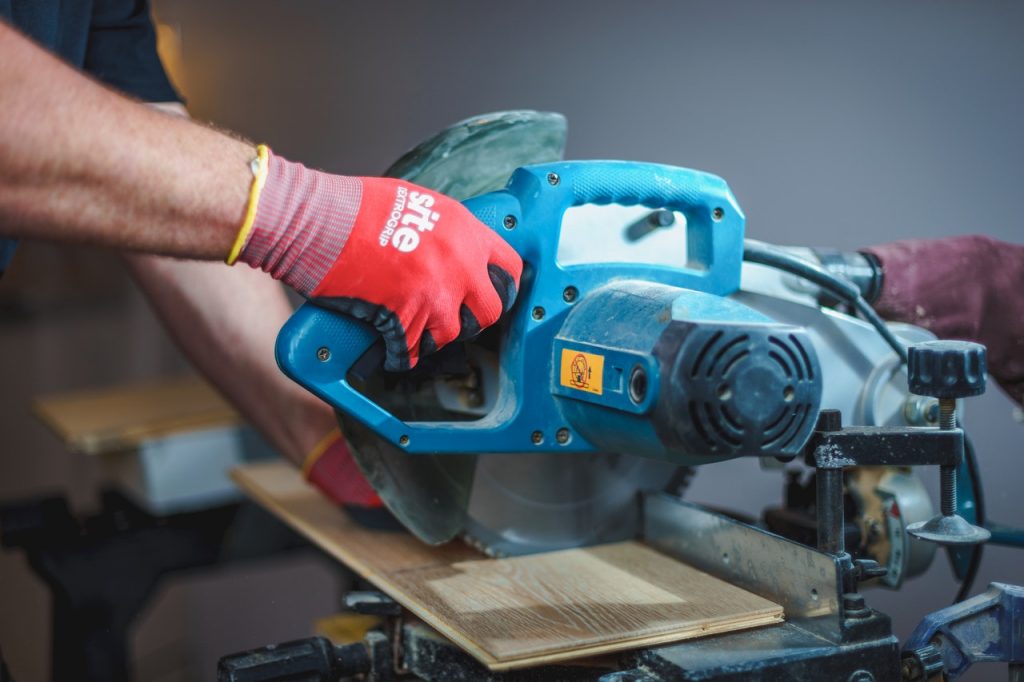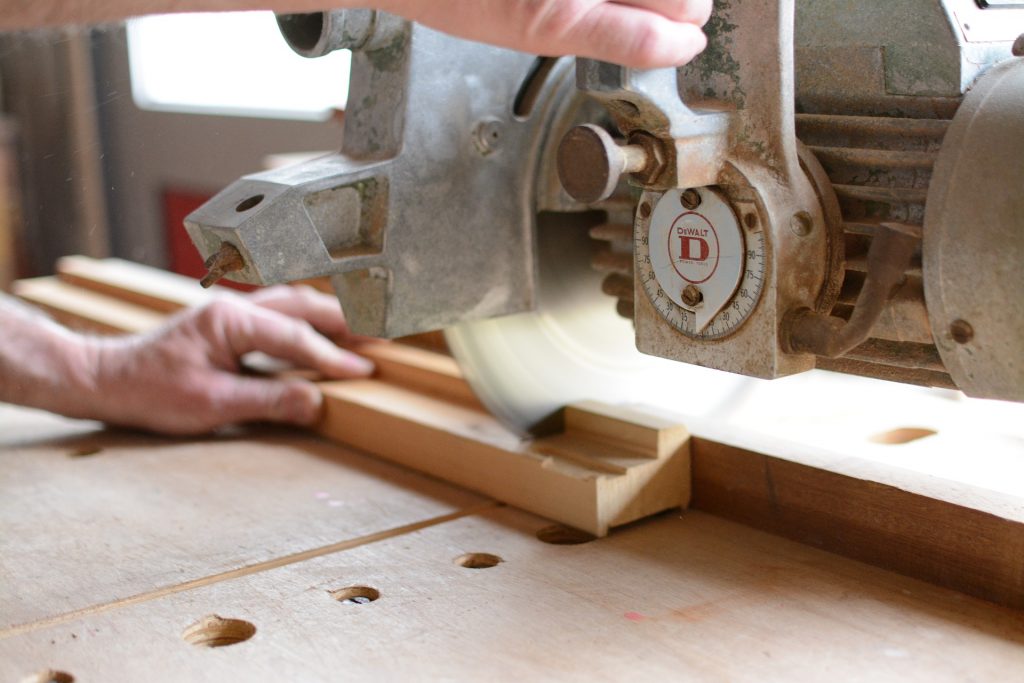Circular saws are highly versatile tools designed for unique specialized tasks.
Cutting at different depths and widths is one of the advantages of owning a circular saw. However, operating a circular saw for cutting posts can be a bit tricky.
Here is a method that will make the job easier for you.
Quick Summary
By the end of this guide, we will go through
- How to cut 4×4 posts with your circular saw
- Different blade types that are in the market
- Some methods used to cut 4x4s
Let’s take a look at it.
How to cut a 4 x 4 post with a circular saw?
4 x 4 posts are one of the most common pieces used in construction. They are both thick to be used for fencing and light to be handled with ease. However, cutting them with most saws is a bit tricky.
As discussed above, circular saws are highly versatile. Due to their usability, we recommend that you use a circular saw for cutting fence posts.
Here is a recommended method that you can use for making the job easier
Step # 1 – Measure the wood
The first step is to take measurements of where you want to cut. Make sure that you mark down all sides of the post using a lead pencil. Also, verify that the lines meet at the right angle. You can measure the angle using a protractor.
Keep in mind that you will need to make two cuts to saw the fence post completely. This is because a circular saw as a miter saw, has a maximum depth of 2.5 inches.
Step # 2 – Secure the wood
This is an important step accuracy-wise. We recommend that you tightly secure the lumber to a cutting table using clamps. By doing this, the lumber won’t be sliding off during cutting.
Step # 3 – Adjust the cutting depth
Before cutting, you need to adjust the depth of the blade. Make sure that the blade has been adjusted to the maximum cutting depth.
When testing different saws, we noted that most mini circular saws have a cutting capacity of between 1 and 2.5 inches. A 4.5-inch circular saw can cut up to 1.7 inches. A 7 ¼ inch saw can cut up to 2.5-inch sheets.
You can adjust the depth by:
- Loosening the depth-adjusting lever or knob
- Pivoting the saw’s base. Do this until the blade extends about a quarter to half an inch below the board
- Tighten the lever or knob
After you have done this, you are ready to saw.
Step # 4 – Make the first cut
Make sure that you have completed all the necessary steps before you plug in the saw. Then power up your saw and allow the saw blade to reach its maximum RPM.
Cut the piece in one pass and a straight line.
Step # 5 – Make the second cut
As discussed earlier, your circular saw cannot cut lumber thicker than 2.5 inches. You need to make 2 cuts for thicker wood and complete the job.
First, you need to rotate the wood piece. You can either unscrew the wood piece and flip the lumber or rotate the table.
After you rotate the post, repeat step 4. Plugin the saw, press the trigger, and cut. Afterward, release the trigger and allow the blade to stop. Lift the saw and your wood should be cut into two pieces.
You can check the accuracy of the cuts by putting together the edge of the piece.
By following these five simple steps, you can make cuts of any kind using your circular saw.
Types of circular saw blades
Circular saws are highly versatile power tools. Due to their portability, they have more utility than a table saw or a miter saw. They can also be used for cutting different types of materials.
However, you need a different blade for different cuts. Here are the types of tools that you can find in the market depending on the job
Rip cut
Rip cuts are the type of cuts you make along the fibers of the workpiece. Blades for rip cutting have less than 30 teeth. These also have a deeper gullet. The result is usually a fast and rough cut. These also have a somewhat thick kerf size.
Crosscutting
Cross-cutting is done along the width. To make a cross-cut, we recommend that you get a blade designed for making crosscuts. These blades have more than 60 teeth. They also have a shallower gullet.
By using a cross-cut blade, you will get a slower but more cleaner cut. They also have a thinner kerf size.
Metal cutting
Metal cutting requires specialized blades. These can cut both ferrous and non-ferrous materials. A blade for metal cutting has no teeth and features expansion slots.
Masonry jobs
Cutting bricks and stones is very different from woodcutting. A blade for masonry jobs doesn’t have any teeth. It is also made of specialized material. Most are made of fiberglass-reinforced silicon carbide.
They also work differently. These wear away the surface rather than slicing it.
Combination blades
These are general-purpose blades. You can perform both rip cuts and crosscuts with it. A blade of this kind has between 30 and 60 teeth. We recommend that you buy this blade if you want an all-in-one deal.
Plastics
Cutting plastics is a tricky job. It is brittle and the edge needs to be brr free. You can use a specialized blade for cutting plastic or you can use a blade for cutting metals.
Some methods to cut 4x4s
As discussed earlier, the thickness of 4x4s makes them challenging to work with. They can be cut using different tools.
Here are some methods you can use to cut your 4x4s
Miter saw
Miter saws can cut at different depths depending on their blade length. We recommend that you use a 12-inch miter saw. They can easily cut up to 4 inches deep material.
Here is what you need to do:
- You have to secure your 4×4 piece with the saw fence. We recommend that you use a clamp for this purpose.
- Then, you need to adjust the angle of your miter saw.
- After that, rev up your miter saw and cut in a single pass.
An added advantage of using a miter saw is that it gives you precision when making cuts. Miter saws are also easy to use and a 12-inch miter saw cuts deep.
If you need to cut your 4×4 quickly and completely at once, we recommend that you use a miter saw.
Circular saw
A Circular saw is a highly versatile tool. Unlike miter saw, it is portable and has an adjustable depth. However, they cannot cut in one go. You will have to make 2 or more passes.
The number of passes you make depends on the diameter of the saw blade.
To make cuts with a circular saw, you need to:
- Measure the wood using a lead pencil or a marker.
- Secure the wood to a table
- Adjust the cutting depth to its maximum setting
- Make the first pass where you marked the post
- Flip the post and make the second cut
You can also use a jig for this purpose. Simply attach the C-shaped jig to your post. Then, cut the post using your saw.
Chainsaw
Chainsaw is easy to use and can very quickly cut 4×4 posts in a single pass. However, they are not very precise and the cut will not be in a straight line. It is not an ideal type of saw to cut your post. It also has a thicker kerf size and will end with a rougher cut.
We only recommend using this saw if it is the only power tool available to cut your post.
Reciprocating saw
A reciprocating saw has a long blade that goes back and forth. The reciprocating saw has a long blade, hence it has no problem cutting through the 3.5-inch depth of your post. There is one drawback to it. Reciprocating saws are not designed for clean or smooth cuts.
- You can construct a C-shaped jig to mitigate issues with accuracy.
- Make a cutline on the post, attach the guard to the post using screws, and line up the guard with the cut line.
- Cut with the reciprocating saw, keeping the blade flush against the metal flashing of the jig.
Although the saw is not as accurate or precise as other saws, you can use the metal guide for a comparatively better result.
Table Saw
A 10-inch table saw has a maximum cutting depth of 3.5 inches making it big enough to cut 4x4s with ease. They can also be used for rip cuts that no other power tool could. However, a table saw has one drawback that it cannot be used for crosscuts.
To cut with a table saw, you just have to slide the piece along the cutline. In this way, you will be able to cut your piece in a single pass.
Hand saw
Using a hand saw is a tiring process as it is not a power tool. However, handsaws are also the most accurate cutting tools.
Before you cut, draw a cut line along with the material. It will guide you and also make sure that you are cutting in a straight line. Then, make a groove with a back cut. Make this groove thick enough that the blade can easily slide through.
Once you have made the groove, start making long cuts. Cut in long strokes and use as much of the blade as possible.
This will make for a smoother cut and help keep the blade in line with the cut line. Be sure to stop at times and check the cut. We recommend that you make adjustments to your hand saw accordingly.

Things to look out for in circular saws
Power Source
This type of saw can both be corded or cordless. Cordless saws work on battery power and usually have a lower RPM and power output. However, these power tools are also more portable than corded saws.
Corded saws have more versatility. You can attach different types of blades to it. They can also be used for different types of jobs such as for steel or masonry projects.
Saw blades
As discussed earlier, saw blades come in a variety of different shapes and sizes. There are different blades for metals, plastics, masonry materials, and wood.
Blades also have features such as expansion slots and carbide-tipped teeth. We recommend that you purchase a blade that is highly durable as well as remains sharp for a long time.
Cutting Capacity
The larger the blade, the deeper the cut. The most common blade diameter is 7-1/4 inches.
Most saws with blade capacities of 6 inches or more can cut through 2-inch lumber at a 45-degree angle in a single pass.
A 5 ⅜ inch saw can cut through 2-inch lumber in one pass at 90 degrees but requires two passes at 45 degrees.
Wrapping things up
We hope that you find this article helpful.
We agree that cutting 4x4s can be tricky and requires some skill. However, you can make this job easier for yourself by following the above guide step by step.
With this, we reach the end of our article on “How to cut a 4×4 post with circular saws”.
Please leave a comment and let us know about your experience.

